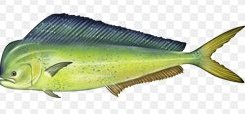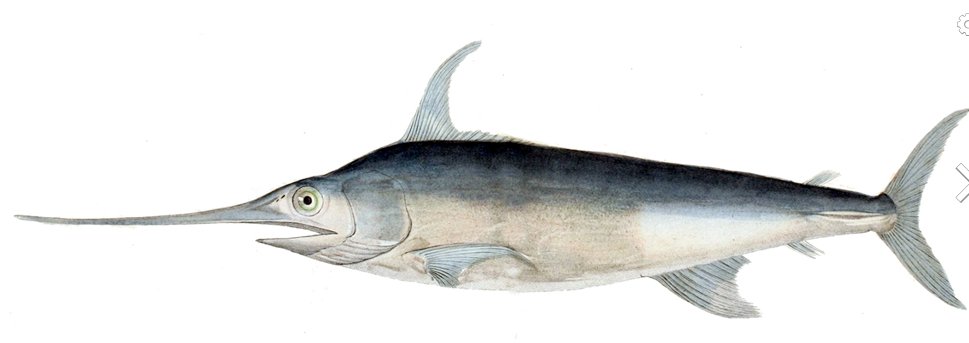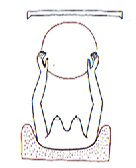"Dorado, the Goldfish,
first published by Bayer among his new southern
figures, is still thus known in Germany and
Italy, but the French say Dorade; and
Flammarion has Doradus, perhaps from
confusion with its supposed genitive case. The
word is from the Spanish, and refers not to our
little exotic cyprionoid, but to the large
coryphaena of the tropical seas, of changing
colors at death.

... The
alternative title Xiphias, the Swordfish, I first find in the
Rudolphine Tables of 1627; Halley used it, in addition to
Dorado, in his catalogue of 1679; Flamsteed gave both names in his
edition of Sharp's catalogue; and the modern Stieler's planisphere
still has Schwerdfisch.

Xiphias, however, had
appeared in astronomy in the first century of
our era, for Pliny applied it to sword-shaped
comets, as Josephus did to that 'which for a
year (!) had hung over Jerusalem in the form of
a sword', - possibly Halley's comet of A.D. 66."
(Allen)
With
Hanga Takaure beginning in Anakena 11 - in ║July 7 (*108)
according to our own calendar - we should look for Tama
earlier in the text:
|
Hanga Takaure: |
 |
 |
 |
 |
 |
 |
 |
|
Ga2-18 |
Ga2-19 |
Ga2-20 |
Ga2-21 |
Ga2-22 |
Ga2-23 |
Ga2-24 |
|
ρ Gemini
(112.1), Eskimo Nebula (112.2)
Antares
|
Al
Dhirā'-5 /
Punarvasu-7 |
ANA-TAHUA-VAHINE-O-TOA-TE-MANAVA |
α
Monocerotis (115.4), σ Gemini (115.7) |
κ Gemini
(116.1),
POLLUX
(116.2), π Gemini (116.9) |
Azmidiske (117.4) |
φ Gemini
(118.4) |
|
CASTOR
(113.4) |
υ Gemini
(114.0), Markab Puppis (114.7), ο Gemini (114.8),
PROCYON
(114.9) |
|
Anakena 11 (*112) |
12 (193) |
13
(*480) |
14 |
15 |
16 |
17
(*118) |
|
║July 7
(*108) |
8 |
9 |
10 |
11 |
12 (193) |
13 |
|
'June 14
(*85) |
15 |
16 |
17 |
18 |
19 |
20 (171) |
|
"May 31
(151) |
"June 1 |
2 (*73) |
3 |
4 |
5 |
6 (*77) |
|
ν Aquilae (Ant.)
(295.0), Albireo (295.5) |
μ Aquilae (296.3), ι
Aquilae (Ant.) (296.8), κ Aquilae (Ant.) (296.9) |
ε Sagittae (297.1), σ
Aquilae (Ant.) (297.4), Sham (297.8) |
β Sagittae (298.0), χ
Aquilae (298.3), ψ Aquilae (298.8) |
υ Aquilae (299.1),
Tarazed (299.3), δ
Sagittae (299.6), π Aquilae (299.9) |
Sravana-23 |
ι Sagittarii (301.2),
Terebellum, ξ Aquilae (301.3),
Alshain (301.6), φ Aquilae (301.8) |
|
ζ Sagittae (300.1),
ALTAIR (300.3), ο
Aquilae (300.5), Bezek (300.8) |
|
January
10 (*295) |
11 |
12 (377) |
13 |
14 |
15
(*300) |
16 |
|
║Jan 6 |
7 |
8 |
9 |
10
(*295) |
11 |
12 (377) |
|
'Dec 14
(*268) |
15 |
16 (350) |
17 |
18 |
19 |
20 (354) |
|
"Nov 30
(*254) |
"December 1 |
2 (336) |
3 |
4 |
5 |
6 (*260) |
The
kuhane journey in the night had no dates nor distances measured
out:
... The dream soul went
on and came to Te Piringa Aniva. She named the place 'Te
Piringa Aniva A Hau Maka O Hiva'. Again the dream soul went on
her way and reached Te Pei. She named the place 'Te Pei A
Hau Maka O Hiva'. The dream soul went on and came to Te Pou.
She named the place 'Te Pou A Hau Maka O Hiva'. The dream
soul went on and came to Hua Reva. She named the place 'Hua
Reva A Hau Maka O Hiva'. The dream soul went on and came to
Akahanga. She named the place 'Akahanga A Hau Maka O Hiva'.
The dream soul went on.
She was careless (?) and broke the kohe plant with her feet.
She named the place 'Hatinga Te Koe A Hau Maka O Hiva'.
The
dream soul went on and came to Roto Ire Are. She gave the
name 'Roto Ire Are A Hau Maka O Hiva'. The dream soul went on
and came to Tama. She named the place 'Tama', an evil
fish (he ika kino) with a very long nose (he ihu roroa)
...
The explorers made landfall at another spot on the Easter Island proper than where the kuhane had reached the land. But from Te Pou (Sirius) order
was established:
"On the fifth day of the month of July
('Anakena'), they all got up, went downhill, went on, and
reached Hanga Te Pau. They took the provisions with them,
carrying them on their shoulders, went on, and reached Te Pou.
They made camp and slept in
Te Pou on
the tenth day of the month of July ('Anakena').
Then they all got up, carried their provisions on their shoulders,
went straight ahead, and followed the path of the dream soul of
Hau Maka."
 |
 |
 |
 |
|
Ga2-5 |
Ga2-6 (36) |
Ga2-7 |
Ga2-8 |
|
ν
Puppis (99.2),
ψ3 Aurigae
(99.4), ψ2
Aurigae
(99.5)
Gemma
|
ψ4 Aurigae
(100.5), Mebsuta (100.7) |
SIRIUS
(101.2), ψ5
Aurigae
(101.4), ν Gemini (101.6),
ψ6 Aurigae
(101.7) |
τ
Puppis (102.2),
ψ7 Aurigae
(102.4) |
|
June
28 (*465) |
29
(180) |
30 |
Anakena 1 |
|
St
John's Eve |
║June 25 |
26
(177) |
27
(*464) |
|
'June 1 (152) |
2
(*73) |
3
(520 |
4 |
|
"May 18 (*58) |
19 |
20
(140) |
21 |
|
no star listed (282) |
ζ Pavonis (283.4), λ
Cor. Austr. (283.6),
Double Double (283.7),
ζ Lyrae (283.8) |
South Dipper-8 |
Sheliak, ν Lyrae
(285.1), λ Pavonis (285.7)
Atlas
|
|
Φ
SAGITTARII
(284.0), μ Cor. Austr. (284.6), η Cor. Austr., θ
Pavonis (284.8) |
|
December 28 |
29 |
30
(364) |
31
(*285) |
|
Christmas Eve |
║December 25 |
26
(360) |
27
(*281) |
|
'December 1 (*255) |
2
(336) |
3 |
4 |
|
"November 17 |
18 (322) |
19
(*243) |
20 |
 |
 |
 |
 |
|
Ga2-9 |
Ga2-10 |
Ga2-11 (41) |
Ga2-12 |
|
θ
Gemini (103.0),
ψ8 Aurigae
(103.2),
Alhena
(103.8), ψ9
Aurigae
(103.9) |
Adara
(104.8) |
ω
Gemini (105.4),
Alzirr
(105.7),
Muliphein
(105.8), Mekbuda (105.9) |
7h
(106.5) |
|
no
star listed (106) |
|
Anakena 2 |
3
(*104) |
4 (185) |
Hanga Te Pau |
|
║June 28 |
29
(*466) |
30
(181) |
║July 1 |
|
'June 5 |
6
(157) |
7
(*78) |
8 |
|
"May
22 |
23
(*63) |
24
(144) |
25 |
|
Ain al Rami (286.2),
δ Lyrae (286.3), κ Pavonis (286.5), Alya (286.6) |
ξ Sagittarii
(287.1), ω Pavonis (287.3), ε Aquilae, ε Cor.
Austr., Sulaphat (287.4), λ Lyrae (287.7),
Ascella, Bered
(Ant.) (287.9) |
Uttara Ashadha-21 |
19h
(289.2) |
|
NUNKI (288.4), ζ
Cor. Austr. (288.5), Manubrium (288.8), ζ
Aquilae (288.9) |
λ Aquilae (Ant.)
(289.1), γ Cor. Austr (289.3), τ Sagittarii
(289.4), ι Lyrae (289.5), δ Cor. Austr. (289.8)
|
|
January 1 (366) |
2 |
3
(*288) |
4 |
|
║December 28 |
29 |
30
(364) |
31
(*285) |
|
'December 5 |
6
(*260) |
7 |
8
(342) |
|
"November 21 |
22
(326) |
23 |
24
(*248) |
 |
 |
 |
 |
 |
|
Ga2-13 |
Ga2-14 |
Ga2-15 (45) |
Ga2-16 |
Ga2-17 |
|
Wezen (107.1), τ Gemini (107.7), δ
Monocerotis (107.9) |
no star listed (108) |
λ Gemini (109.4),
Wasat
(109.8) |
no star listed (110) |
Aludra (111.1), Propus (111.4), Gomeisa
(111.6) |
|
Anakena 6 (*107) |
7 |
8 |
9 (190) |
Te Pou |
|
║July 2 |
3 (184) |
4 (*471) |
5 |
6 (*107) |
|
'June 9 (160) |
10 |
11 |
12 |
13 (*84) |
|
"May 26 |
27 |
28 (*68) |
29 |
30 (150) |
|
Al Baldah-19 |
Aladfar
(291.1), Nodus II (291.5), ψ Sagittarii
(291.6), θ Lyrae (291.8) |
ω Aquilae
(292.1), ρ Sagittarii (292.6), υ Sagittarii
(292.7) |
Arkab Prior
(293.0), Arkab Posterior, Alrami (293.2), χ
Sagittarii (293.6) |
Deneb Okab
(294.0), α Vulpeculae (294.9) |
|
AL BALDAH,
Alphekka Meridiana (290.1), β Cor. Austr.
(290.2) |
|
January 5 (*290) |
6 |
7 (372) |
8 |
9 |
|
║Jan 1 (366) |
2 |
3 (*288) |
4 |
5 |
|
'December 9 |
10 (*264) |
11 |
12 (346) |
13 |
|
"November 25 |
26 (*250) |
27 |
28 |
29 (333) |
If this is
true, then the explorers may have gone from Te Pou to
Hanga Takaure in a single day, from Ga2-17 to Ga2-18. Passing on
their way the 5 stations Hua Reva, Akahanga,
Hatinga Te Koe, Roto Ire Are, and Tama.
However,
considering the Gregorian calendar, with
║July 1 (= Anakena 5) = Hanga
Te Pau, it is more reasonable to assume these 5 stations each
could have been given 1 dark night outside the ordinary calendar:
 |
 |
 |
 |
|
 |
|
Ga2-13 |
Ga2-14 |
Ga2-15 (45) |
Ga2-16 |
Ga2-17 |
|
Wezen (107.1), τ Gemini (107.7), δ
Monocerotis (107.9) |
no star listed (108) |
λ Gemini (109.4),
Wasat
(109.8) |
no star listed (110) |
Aludra (111.1), Propus (111.4), Gomeisa
(111.6) |
|
Hua Reva |
Akahanga |
Hatinga Te Koe |
Roto Ire Are |
Tama |
|
Anakena 6 (*107) |
7 |
8 |
9 (190) |
Te Pou |
|
║July 2 |
3 (184) |
4 (*471) |
5 |
6 (*107) |
|
'June 9 (160) |
10 |
11 |
12 |
13 (*84) |
|
"May 26 |
27 |
28 (*68) |
29 |
30 (150) |
... Nut, whom the Greeks
sometimes identified with Rhea, was goddess of the sky, but it was
debatable if in historical times she was the object of a genuine
cult. She was Geb's twin sister and, it was said, married him
secretly and against the will of Ra. Angered, Ra had the couple
brutally separated by Shu and afterwards decreed that Nut could not
bear a child in any given month of any year. Thoth, Plutarch tells
us, happily had pity on her. Playing draughts with the Moon, he won
in the course of several games a seventy-second part of the Moon's
light with which he composed five new days. As these five
intercalated days did not belong to the official Egyptian calendar
of three hundred and sixty days, Nut was thus able to give birth
successively to five children: Osiris, Haroeris (Horus), Set, Isis
and Nepthys.
Sirius
followed the Sun and precession did not have any effect on him.
Therefore it could have been necessary to define where in the
calendar Te Pou ideally should be, and why not 10 days after
his true heliacal rising in ║June
30, the day before Anakena 1. The 'Child' (Tama) would then
be the last phase of Te Pou (Sirius).
With Anakena as month number 7 we could read Anakena 10 as 7-10 and an allusion to 71 years for a precessional day. In the Gregorian calendar the 2nd half of the year could be perceived as beginning with heliacal Sirius and
given a notch for the completion of this day with ║July 1. Similarly, the completion of
the dark nights of Te Pou could be carved into the G tablet at Ga2-18, when Antares culminated at midnight - a Sign impossible not to notice.
The
nakshatra view could therefore be reflected in the glyphs and also
in the 5 nights at the beginning of the Gregorian calendar:
 |
 |
 |
 |
|
 |
|
Ga2-13 |
Ga2-14 |
Ga2-15 (45) |
Ga2-16 |
Ga2-17 |
|
Al Baldah-19 |
Aladfar
(291.1), Nodus II (291.5), ψ Sagittarii
(291.6), θ Lyrae (291.8) |
ω Aquilae
(292.1), ρ Sagittarii (292.6), υ
Sagittarii (292.7) |
Arkab
Prior (293.0), Arkab Posterior, Alrami
(293.2), χ Sagittarii (293.6) |
Deneb
Okab (294.0), α Vulpeculae (294.9) |
|
AL BALDAH,
Alphekka Meridiana (290.1), β Cor.
Austr. (290.2) |
|
Hua Reva |
Akahanga |
Hatinga Te
Koe |
Roto Ire Are |
Tama |
|
January 5 (*290) |
6 |
7 (372) |
8 |
9 |
|
║Jan 1 (366) |
2 |
3 (*288) |
4 |
5 |
|
'December 9 |
10 (*264) |
11 |
12 (*266) |
13 |
|
"November 25 |
26 (*250) |
27 |
28 |
29 (333) |
Looking at
the face of the Full Moon the Gregorian date ║January 1 could have
corresponded to the rising fish and to Hua Reva (Uplifted
Fruit).

|
Reva To hang down; flag, banner.
Revareva, 1. To be hanging vertically; to detach
oneself from the background of the landscape, such a person
standing on top of a hill: ku-revareva-ß te tagata i ruga
i te ma˙ga. 2. To cast itself, to project itself (of
shadows); revareva-ß te kohu o te miro i te maeha o te
mahina, the shadow of the tree casts itself in the light
of the moon. 3. Uvula. Vanaga.
To hang, to suspend, flag, banner;
hakareva, to hang up; hakarereva, to hang up, to
balance; hakarevareva, to wave. T Pau.: reva,
a flag; fakarevareva, to hang up, to suspend. Mgv.:
reva, a flag, a signal. Mq.: Úva, to hang up,
to be suspended, to wave a signal. Ta.: reva, a flag,
banner; revareva, to wave. The germ sense is that of
being suspended ... any light object hung up in the island
air under the steady tradewind will flutter; therefore the
specification involved in the wave sense is no more than
normal observation. Churchill.
Mgv.: 1. A plant. Ta.: reva, id.
Mq.: eva, id. Sa.: leva, id. Ma.: rewa-rewa,
id. 2. To cross, to pass across quickly; revaga,
departure. Ta.: reva, to go away, to depart. Ma.:
reva, to get under way. Churchill.
Ta.: The firmanent, atmosphere. Ha.:
lewa, the upper regions of the air, atmosphere, the
visible heavens. Churchill. |
LEWA,
s. Haw., the upper air, region of
clouds; v. to swing, float in the
air, move back and forth; hoo-lewa,
to vibrate, float in the air, carry between
two persons, as a corpse, a funeral. Tah.,
rewa, the firmanent, an abyss;
rewa-rewa, to fly about, as a flag.
Mangr., rewa, the overhanging
firmanent, a tent, a flag.
N. Zeal.,
rewa, the eyelid. Marqu., ewa, to
suspend; s. the middle. Sam., leva
(of time), long since; v. be
protracted. Fiji., rewa, high,
height; vaka-rewa, to lift up, to
hoist, as a sail.
Malg.,
lifa, v. to fan oneself, s.
flight; rafraf, a fan.
Goth.,
luftus, the air. Sax., lyfti,
air, arch, vault. O. Engl., lift,
air. Lat., limbus (?), fringe,
flounce.
Sanskr.,
dev, div, primarily 'jacere,
jaculare', according to A. Pictet (Orig.
Ind.-Eur., ii. 466), subsequently 'to play
at dice', play generally. The permutation of
d and l may be observed in the
Latin levir, brother-in-law (the
husband's younger brother) = Sanskr.
devŗi,
devara,
id.
If
dev
or div
has derived the sense of 'throwing dice'
from an older sense 'jacere, jaculare', to
throw, to hurl, that sense may be a
derivative from a still older one, 'to lift
up, swing about, be suspended' = the
Polynesian lewa,
rewa,
'to be suspended, to vibrate'. And thus we
can also understand the origin of the Goth.
luftus,
the Sax. lyfte,
the O. Norse loft,
Swed. lowera,
lofwa,
Engl. luff.
(Fornander)
|
The name
Akahanga carries -hanga as an indication of a bay = curve
and the shark (mago) in Ga2-14 has a curved tail.
| Aka
1. Anchor: he-hoa te aka, to
drop anchor. 2. Root of certain plants (banana tree,
taro, sugar-cane). 3. To be paralyzed by surprise.
Vanaga.
1. Root; aka totoro, to take
root. P Pau., Mq.: aka, root. Ta.: aa, id.
2. (āka)
anchor. 3. Causative (haka).
Churchill. |
║December
31 (365) is one more than 52 weeks and needed in the calendar to
make it possible to indicate with a 'notch' the completion of these
52 weeks. January 6 (*291) - Akahanga - could similary have
meant the place beyond the night 290 days after March 21, where the
old year should move no further, 'drop anchor'.
In the time
of Al Sharatain this place in the night sky calendar was 264
(= 364 - 100) days after 'March 21 and in the time of Bharani
it was 250 days after "March 21. The straight 'thread' inside the
head of mago in Ga2-14 is abruptly cut off.
Hatinga
Te Kohe - where the kuhane with her feet broke the
'bamboo stem of time' - could indicate the necessity to make a break
(just like how the Turtle somewhat later broke the spine of
Kuukuu with one of her flippers).
| Kohe
A plant (genus Filicinea) that
grows on the coast. Vanaga.
Vave kai kohe, inaccessible.
Churchill.
*Kofe is the name for bamboo on
most Polynesian islands, but today on Easter Island
kohe is the name of a fern that grows near the
beach. Barthel 2. |
|













